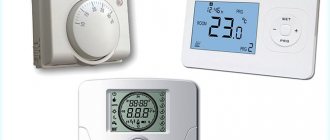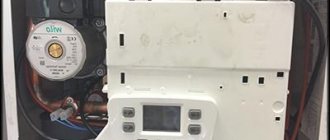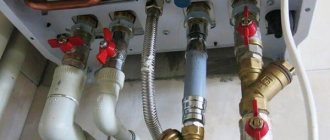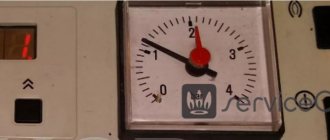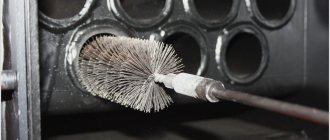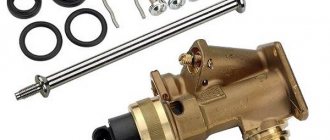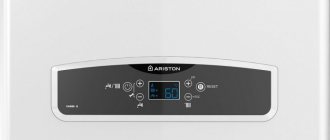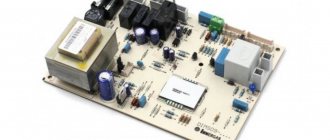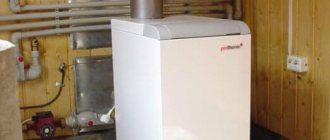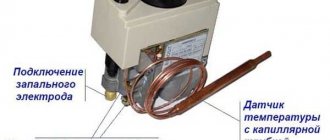Principle of operation
The gas boiler operates cyclically, turning on when the temperature of the coolant (water) drops to a certain value, which you set manually. Then the pump starts working.
The lack of automation leads to the need to adjust the parameters of the heating system throughout the cold season. But even manual adjustment does not guarantee that on particularly cold days the apartment or house will not freeze, and on a warm sunny day it will not turn into a sauna.
It is for these purposes that thermostats are used.
They are equipped with an air temperature sensor for the heated room. You yourself can set the desired temperature on the thermostat - it will automatically turn on the gas boiler and pump at the right time, and only for the required period of time.
Unlike a gas boiler, for which the most important parameter is the temperature of the coolant, the temperature of the air in the room is important to the thermostat.
You once set the minimum possible temperature at which you feel comfortable being in a room without heating. As soon as the air temperature drops below this value by 0.25-1 degrees (the step depends on the device model), the thermostat automatically starts the boiler and pump.
If the temperature exceeds the threshold you set by the same 0.25-1 degrees, the thermostat will automatically turn off the heating system.
We have the best price for a room thermostat for a gas boiler!
Our established relationships with manufacturers allow us to offer our customers reasonable prices for products that are worthy in all respects. Prices for a room thermostat for a gas boiler start from 2000 rubles and can be supplemented with favorable discounts!
So I became the happy owner of a gas boiler, which I just had to connect to the thermostat. Of course, I could call a specialist and pay for his work, but this is not in my rules; I decided to connect the room thermostat to the gas boiler with my own hands. The article describes several ways to do this.
Installers advise installing thermostats in living rooms. Their installation in the kitchen, hallway or boiler room leads to system disorientation and false alarms. It is recommended to choose the coolest room or where there are the most people.
No heat sources such as radiators or heaters should be located near the thermostat. The device should not be exposed to direct sunlight. It is necessary to avoid placing the thermostat in a draft. It is also undesirable to be near electrical appliances that emit thermal noise.
The boiler is turned on and off by a special relay. The thermostat is connected using a terminal on the boiler at a specified location or via a thermostat cable. The programmer requires batteries to operate.
Before connecting the room thermostat, you need to read the instructions, which are located in the technical data sheet of the device. Usually the passport has a separate section dedicated to connecting the thermostat.
Three main advantages of thermostats
Automation for a gas boiler
The air in the room does not cool down as quickly as the coolant in the circuit, so the number of starts of the heating unit is reduced many times over, which has a beneficial effect on its service life and your financial condition.
As stated above:
- they increase the level of comfort - the room temperature will be stable in any weather, only the frequency of switching on the heating system will change;
- eliminate the need for frequent adjustment of boiler parameters;
- significantly reduce heating costs.
In normal mode, the boiler fires on average once every 10 minutes and heats the water for 1-2 minutes, while the pump operates constantly. If there is automation, the boiler will turn on much less frequently, and the pump will work only when necessary, pumping the heated coolant through the circuit.
READ ALSO: All about GSM modules for heating boilers: controller functions, popular models, operation
According to some reports, savings can be up to 25-30% , which makes the device very effective and quickly pays for itself.
Thermostat functionality
A room thermostat is a small unit with controls that is mounted at one point or another in an apartment or house. By connecting to a heating boiler, it allows you to control its operation, control the temperature in the room, and set certain operating modes. A room thermostat is convenient when the boiler is located in a technical room or in the basement. It will also be useful in large houses - for example, we can set the desired temperature from a thermostat located on the second floor, while the boiler is on the first floor or in the basement of the building.
There is no need to install the thermostat in close proximity to the heating equipment.
A room thermostat cannot be called a vital device. On the contrary, we can do without it, saving money in the budget. The thermostat only provides ease of control of heating equipment. It will also be able to save money in your wallet, being equipped with a built-in temperature sensor. Let's see what functions a room thermostat has:
- Controlling the temperature in the heating circuit - just turn the knob or set the required value using the buttons;
- Setting the temperature during the day and at night - we create a comfortable environment at any time of the day;
- Programming operating modes - for example, during the daytime the temperature can be reduced, since all household members are at work. Towards evening, the room thermostat will command the temperature to increase to make the rooms warmer;
- Temperature control using a built-in sensor – ensures gas savings;
- Control of additional equipment - for example, weather-compensating automation or a solar collector.
The simplest room thermostats have minimal functionality. The basic function is temperature control, and we can call all the others service functions.
Types of room thermostats
Automation for regulating boiler operation can be divided into:
- Wired – communication between the boiler and the controller is provided by a wired connection (requires additional installation).
- Wireless - the entire work process is controlled using a radio signal.
The wireless thermostat kit includes two units, one of which is installed near the boiler and connected to its terminals, and the second is installed in the room from which the operation of the heating system is supposed to be controlled.
Both blocks are connected to each other via a radio channel. For ease of use, the control unit is equipped with a mini-keyboard and a liquid crystal display.
Wireless thermostat programmer
According to the functions they perform, room thermostats are divided into:
- Simple - they can only maintain a preset temperature in the room.
- Programmable – they are also called programmers. They have a rich set of functions: you can change a number of boiler parameters remotely, adjust the “day” and “night” temperature modes, and program the heating system by day of the week.
- With a built-in hydrostat function , they allow you to monitor the humidity level in any room where there is a need to control the microclimate. They have a built-in mode for reducing and increasing humidity.
Popular models and manufacturers
The most popular on the Russian market are temperature sensors from brands such as Siemens, IMIT, Thermolink and Baxi.
The range of manufacturers is very wide and includes both entry-level models and serious thermostats for multi-circuit boilers with a wide range of additional functions.
Let's look at several popular models and compare their characteristics.
| Model | Range | Difference, °С | Degree of protection, IP | Connection | Display | Programming | Price |
| IMIT TA3N 70 | +5 — +30 °С | 1 | 30 | 2-wire | No | No | 600 |
| Siemens RAA 21 | +8 — +30 °С | 30 | 2-wire | No | No | 1200 | |
| IMIT BLUE | +6 — +35 °С | 0,2-0,4 | 20 | 2-wire | Eat | Yes | 3300 |
| IMIT BLUE RADIO | +6 — +35 °С | 0,2-0,4 | 20 | Radio channel | Eat | Yes | 10 900 |
Thermostat, its types and testing methods
Depending on the design of the device, various methods are used to check the operating condition. As you know, all thermostats can be divided into 3 large groups:
- With mechanical design.
- With electromechanical design.
- With electronic design.
Nowadays, in the production of household appliances, electronic and electromechanical thermostats are most in demand.
Checking a thermostat that has a mechanical design is quite simple. It can be easily found in almost every oven. Check the serviceability of the device in 2 ways:
- First, you need to turn on the oven and set the heating temperature to 100-150 °C. Next we watch the flame. When the oven warms up (after about 5 or 15 minutes), the heat should automatically become smaller to maintain the set temperature.
- The second is using a mechanical thermometer. It is placed in the oven in a metal case. After that, you need to turn on the oven and set the heating temperature (about 150 °C). After about 15 minutes, look at the thermometer inside the oven. Deviation in readings is allowed within 5 degrees.
The thermometer and its scale should be easily visible through the glass of the oven door.
The thermostat of a refrigerator or washing machine is a typical example of a device with an electromechanical design. Two methods are also used for checking:
- 1. – for example, we suspect a malfunction of the washing machine thermostat. To control the heating temperature of the water in the tank, use a multimeter with a thermocouple or a thermometer. We set the washing mode (preferably 40 °C) and after 5 or 10 minutes (necessarily before the 1st drain of water) take the heating readings. Slight error is allowed. Also suitable for testing electronic thermostats.
- 2. – we find the device in the equipment and use a tester to check the contacts that should open when heated. When they are closed in a cold state, the resistance on the measuring device tends to zero. If you turn on the heat and check again after 5 minutes, the pair should open and the tester should show infinite resistance. In the case where there was no rupture, the temperature should be gradually reduced.
Testing an electronic thermostat is a little more difficult. It is necessary to compare the resistance readings when the heating temperature changes, and also to establish the serviceability of the controller and actuator unit.
It is possible to successfully test the thermostat yourself at home. This often helps avoid unnecessary, costly repairs.
Device selection
The thermostat you choose must meet your needs and be technically suitable:
- If it is not possible to install conductors from the thermostat to the boiler, then a wireless model is suitable for you.
- If you want to optimize the operation of your heating system as much as possible, you should take a closer look at programmers and non-volatile boilers.
Thermostat-programmers usually have 2-3 weekly modes, and 3-4 daily ones. This will ensure that the apartment is heated to the required temperature while you are at home, and the system will automatically switch to economy mode while you are away.
Most models have inertia. That is, the heating system is turned on in order to warm up the room before your arrival.
READ ALSO: UPS for a gas boiler: why do you need an uninterruptible power supply, which one is better to choose and how to connect
A good option would be to choose a device from the same manufacturer as your gas boiler. This will avoid installation difficulties (gas boiler connection diagram).
Installation and connection
Connection points: 1 (N0) and 2 (COM) - boiler control, 2 (COM) and 3 (NC) - cooling control
When installing, remember that the quality of its operation depends on the correct choice of placement of the device.
In order for the thermostat to accurately estimate the average room temperature, you should consider some rules:
- Place the device at a height of 1.5 meters above the floor. This is due to the fact that warm air rises, and cold air concentrates below. You should do the same if you have heated floors.
- Install automation only in interior walls. External walls are always a little cooler, even despite the quality of thermal insulation. Air should circulate freely around the temperature sensor.
- The device must not be placed inside cabinets or covered with curtains. The design of most models will fit perfectly into any interior. Eliminate outside influence.
- The thermostat should be located away from heating devices or cold sources (windows, doors). It should not be exposed to air currents from the air conditioner or direct sunlight.
Connection diagrams can be found in the instructions supplied with the device..
You can also use the following information:
- Turn off the power supply to ensure safe work.
- Find a suitable installation location. If necessary, install the installation box and connect phase and neutral to it.
- Connect the thermostat to the boiler. To do this, connect the zero, phase and ground of the thermostat with the corresponding contacts of the gas boiler (standard markings are N, L and PE, respectively).
Tips for use
Programmable thermostat
To reduce fuel and electricity costs, there are several important points to consider:
- Reduce the thermostat temperature if you plan to leave the room for a long time.
- It makes sense to set the temperature 3-4 degrees lower at night. The first family member to rise in the morning can increase the temperature and warm up the room. Automate this process if you purchased a programmable thermostat.
- Keep your device in working order. Change batteries without waiting for the device to fail.
- Make sure that in rooms for the elderly and disabled the temperature does not fall below 16 degrees.
- Recommended temperature : 20 degrees for common areas;
- 18 degrees for a children's room;
- 16-19 degrees at night;
Choosing a gas boiler and thermostat from one well-established manufacturer will avoid many problems associated with the operation of the heating system in the future.
How to use backup power for a gas boiler to protect the heating system from restarts and the possibility of overheating of the coolant. Let's consider a simplified and complex method for calculating the power of a heating boiler https://teplius.ru/kotly/gazovye/vybor-gazovye/raschet-moshhnosti.html
Calculate on your own how much it will cost to heat your house using liquefied gas.
Malfunctions
In some cases, the operation of the device is disrupted by air pockets. They can be eliminated by bleeding the air using a Mayevsky valve. A decrease in heat transfer results from blockage of the pipe passage with sediment or rust. To get rid of dirt, it is recommended to rinse the radiator with special products.
In centralized systems, the temperature of the coolant may decrease as a result of an emergency on the main pipeline or unauthorized actions of neighbors that caused a change in the flow parameters in the common riser. Circulation is worsened by a broken valve at the radiator inlet or an incorrectly installed plug.
We advise you to study the difference between installed and one-time power
Most likely it will be enough:
- release air;
- wash the battery from the inside;
- change the valve.
As a rule, after performing one or several actions, the previous heat transfer is restored.
